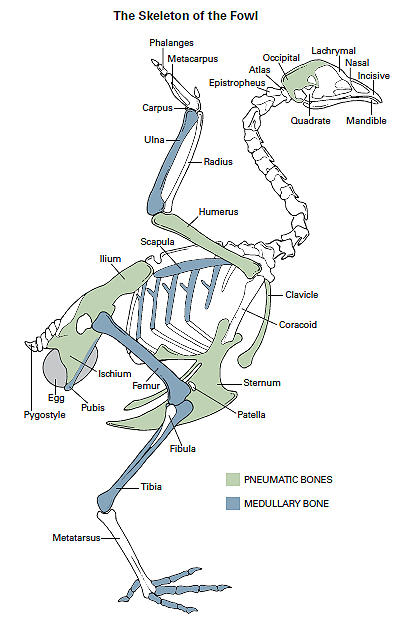



Understanding the Role of the Skeleton in Egg Production
A guide to bone biology in the laying hen is explained by Hy-Line.Soft bones and thin fragile bones are issues that affect producers of high-performing egg layers all around the world. Osteomalacia and osteoporosis most commonly arise from deficiency, imbalance or malabsorption of calcium, phosphorus or vitamin D3.
The effect of skeletal issues on a flock typically is demonstrated by decreased production, crooked keels, fractures and poor shell quality.
All hens require a specific amount of nutrients to maintain production and skeletal structure. The skeletons and dietary requirements of hens are unique relative to the level of calcium consumed and the amount of bone that is constantly being built and resorbed.
When soft bones or poor shell quality is found, usually at least one of the following factors is involved: pullet growing, nutrition, feed consumption or disease.
| Crooked: not straight; having curves |
| Labile: constantly undergoing change |
| Osteomalacia: decalcification or softening of bones due to bone mineralisation issues caused by insuffi cient levels of available phosphorus and calcium or due to excessive resorption of calcium from the bone |
| Osteoporosis: a progressive bone disease resulting in decreased bone mass and density |
| Resorb: to dissolve/break down and assimilate |
| Resorption: destruction or loss of tissue or bone |
Overview of Bone Biology
The avian skeleton is a unique system that is specialized for flying, walking on two legs and laying eggs. Establishing and maintaining a strong skeleton is vital to ensure a productive laying hen. In order to understand the impact of diet on the laying hen, it is important to understand the biology of the skeleton.
There are three different types of bone: cortical, trabecular and medullary.
- Cortical bone is the hard outer surface of the round bones, such as the femur or the humerus, and the fl at bones, such as the skull or the pelvis.
- Trabecular or spongy bone is less dense than cortical bone and helps support the structure inside the cortical bones.
- Medullary bone is a specialized woven bone which serves as a calcium reserve for the demands of egg shell formation. Easily created and resorbed, medullary bone is ideally the first source mobilised when more calcium is required.
While the outside appearance of avian bones is similar to those of mammals, there are several key differences.
- Fused vertebrae – Several thoracic and lumbar vertebral spinal sections are fused together to form a more solid structure for flying.
- Keel – The sternum or keel provides a large surface for attachment of the pectoral muscles, which are important for energy storage and muscle yield.
- Pneumatic bones – Hollow and air-filled, these bones are part of the respiratory system and help with flying.
- Medullary bone – This specialised bone is used as a source of calcium for the egg shell and only occurs in birds and some reptiles.
Bone growth and resorption is controlled and regulated by a few important cells and many different hormones. In healthy, well-fed birds, the cells and hormones work closely together to maintain bone structure and blood calcium levels needed for optimum production.
The important cells for bone growth and modelling are chondrocytes, osteoblasts, and osteoclasts.
Chondrocytes start the basic process for bone growth by secreting type II collagen and other important components for bone formation.
Osteoblasts then produce the type I collagen and the increased levels of calcium and phosphate that result in the mineralisation or ossification of the bone.
Osteoclasts resorb bone for remodelling or for releasing calcium into the blood stream. Bone growth and resorption is regulated by a number of different hormones which control when structural or medullary bone grows or resorbs, depending on the physiologic need.
Growth hormone stimulates cellular growth and protein synthesis throughout the body.
Thyroxine stimulates cell metabolism as well as osteoblast activity.
Melatonin influences osteoblast activity. Melatonin levels are highest when birds are sleeping during the dark period and initiate a cascade of events affecting hormones necessary for egg production.
Oestrogen increases at sexual maturity and changes osteoblast activity from creating cortical and trabecular bone to creating medullary bone. After the first egg, the only way a hen can remodel structural bone is during periods of low oestrogen, such as moult or breaks in lay during the normal production period.
Calcitonin is released when there are high serum calcium levels and decreases osteoclast activity while increasing osteoblast activity which builds bone and lowers serum calcium levels.
Parathyroid hormone (PTH) is released during periods of low serum calcium and binds to osteoblasts. This binding decreases osteoblast activity while releasing a compound that increases osteoclast activity, thus increasing serum calcium levels. Additional properties of PTH include
increasing small intestine absorption of calcium and decreasing urinary excretion of calcium.
Calcitonin and parathyroid hormone work together in feedback loops to ensure the proper levels of serum calcium are maintained.
This series will continue on ThePoultrySite in the coming weeks, covering pullet development, sexual maturity, bone quality during the productive period and nutrition for optimum bone health.
May 2013









